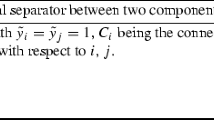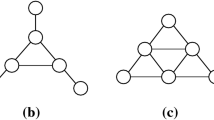Abstract
LetG=(V, E) be a graph andT⊆V be a node set. We call an edge setS a Steiner tree forT ifS connects all pairs of nodes inT. In this paper we address the following problem, which we call the weighted Steiner tree packing problem. Given a graphG=(V, E) with edge weightsw e , edge capacitiesc e ,e∈E, and node setT 1,…,T N , find edge setsS 1,…,S N such that eachS k is a Steiner tree forT k , at mostc e of these edge sets use edgee for eache∈E, and the sum of the weights of the edge sets is minimal. Our motivation for studying this problem arises from a routing problem in VLSI-design, where given sets of points have to be connected by wires. We consider the Steiner tree packing problem from a polyhedral point of view and define an associated polyhedron, called the Steiner tree packing polyhedron. The goal of this paper is to (partially) describe this polyhedron by means of inequalities. It turns out that, under mild assumptions, each inequality that defines a facet for the (single) Steiner tree polyhedron can be lifted to a facet-defining inequality for the Steiner tree packing polyhedron. The main emphasis of this paper lies on the presentation of so-called joint inequalities that are valid and facet-defining for this polyhedron. Inequalities of this kind involve at least two Steiner trees. The classes of inequalities we have found form the basis of a branch & cut algorithm. This algorithm is described in our companion paper (in this issue).
Similar content being viewed by others
References
M.R. Garey and D.S. Johnson, “The rectilinear Steiner tree problem is
 -complete,”SIAM Journal on Applied Mathematics 32 (1977) 826–834.
-complete,”SIAM Journal on Applied Mathematics 32 (1977) 826–834.M. Grötschel, A. Martin and R. Weismantel, “Routing in grid graphs by cutting planes,”Zeitschrift für Operations Research 41 (1995) 255–275.
M. Grötschel, A. Martin and R. Weismantel, “Packing Steiner trees: a cutting plane algorithm and computational results,”Mathematical Programming 72 (1996) (this issue).
M. Grötschel, A. Martin and R. Weismantel, “Packing Steiner trees: further facets,”European Journal on Combinatorics, to appear.
M. Grötschel and C.L. Monma, “Integer polyhedra associated with certain network design problems with connectivity constraints,”SIAM Journal on Discrete Mathematics 3 (1990) 502–523.
R.M. Karp, “Reducibility among combinatorial problems,” in: R.E. Miller and J.W. Thatcher, eds.,Complexity of Computer Computations (Plenum, New York, 1972) pp. 85–103.
B. Korte, H.J. Prömel and A. Steger, “Steiner trees in VLSI-layout,” in: B. Korte, L. Lovász, H.J. Prömel and A. Schrijver, eds.,Paths, Flows. and VLSI-Layout (Springer, Berlin, 1990) pp. 185–214.
M.R. Kramer and J. van Leeuwen, “The complexity of wire-routing and finding minimum area layouts for arbitrary VLSI circuits,” in: F.P. Preparata, ed.,Advances in Computing Research, Vol. 2: VLSI Theory (Jai Press, London, 1984) pp. 129–146.
T. Lengauer,Combinatorial Algorithms for Integrated Circuit Layout, (Wiley, Chichester, 1990).
A. Martin: “Packen von Steinerbäumen: Polyedrische Studien und Anwendung”, Ph.D. Thesis, Technische Universität Berlin, (1992).
A. Schrijver,Theory of Linear and Integer Programming (Wiley, Chichester, 1986).
Author information
Authors and Affiliations
Rights and permissions
About this article
Cite this article
Grötschel, M., Martin, A. & Weismantel, R. Packing Steiner trees: polyhedral investigations. Mathematical Programming 72, 101–123 (1996). https://doi.org/10.1007/BF02592085
Received:
Revised:
Issue Date:
DOI: https://doi.org/10.1007/BF02592085





 -complete,”SIAM Journal on Applied Mathematics 32 (1977) 826–834.
-complete,”SIAM Journal on Applied Mathematics 32 (1977) 826–834.